Last updated: November 5, 2021
Thing to Do
Fly-In Bear Viewing Along the West Cook Inlet Coast

NPS/K. Lewandowski
Leashed pets are permitted in the park and preserve. However, we strongly encourage you to leave your pets at home, for your safety, their safety, and the health of the ecosystem. If your dog is already in Alaska with you, a quick Google search will give you a list of kennels that can board it for you during your trip to Lake Clark. Common park gateway communities with pet boarding facilities include Anchorage, Soldotna, Kenai, Kasilof, Homer, and Anchor Point.
Dogs running loose can bring enraged bears or moose back to their owners. They can also harass or kill local wildlife. While it's pretty obvious when a dog is chasing a moose or a squirrel, a loose dog can eat ground nesting bird eggs and chicks so quickly the owner never realizes it happened. They may also either contract a disease from wild canine populations, or introduce disease to fox, coyote, or wolf through their scat. Be aware that these wild canines are highly territorial, especially during summer denning season, and will kill loose dogs they encounter in their territory.
If you must bring your pet, remember that it must be leashed at ALL times, and that you must properly dispose of its scat by either burying it in a 6 inch cathole like you would your own waste, or by packing (flying) it out.
Each encounter is a learning experience for both bears and people. Appropriate and consistent human responses to bears minimize the chances of dangerous surprise encounters and can provide safer and better bear viewing experiences.
In most cases it is best to stay in the open during the day where bears can see people and avoid them if they wish. Hiding from bears increases the likelihood that people will have a surprise encounter that could result in a dangerous situation for the bear and/or the person.
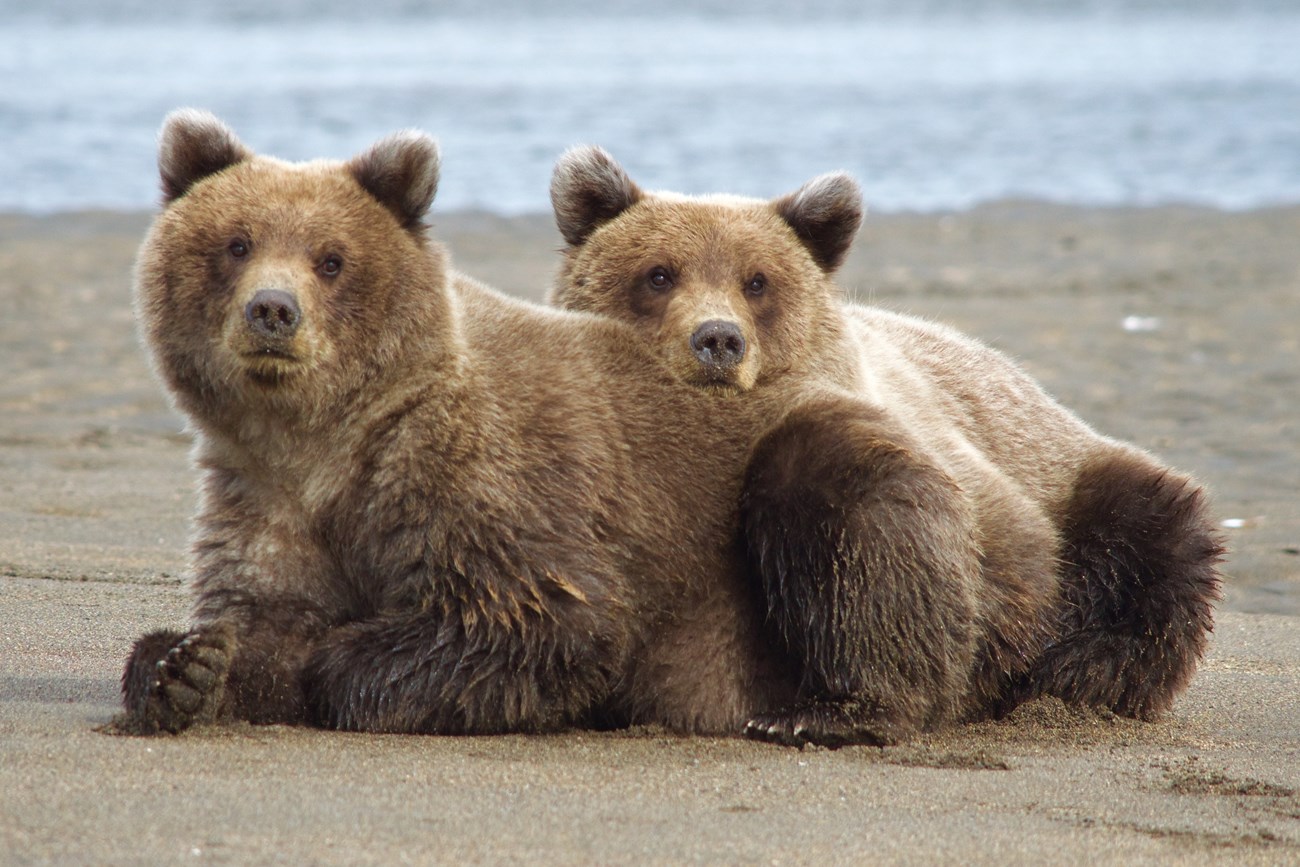
NPS/K. Lewandowski
Where Can I See Bears?
Crescent Lake
Located in the heart of the Chigmit Mountains, Crescent Lake is a sport fisherman's dream. During the salmon run, brown and black bears also frequent the shorelines in search of the plentiful fish.
Silver Salmon Creek
Located midway down the park's Cook Inlet coast, Silver Salmon creek offers outstanding sport fishing in addition to world class brown bear viewing.
Chinitna Bay
Located at the southern end the park's Cook Inlet coast, Chinitna Bay offers world class bear viewing. Visitors may be able to see as many as twenty coastal brown bears from a single location.
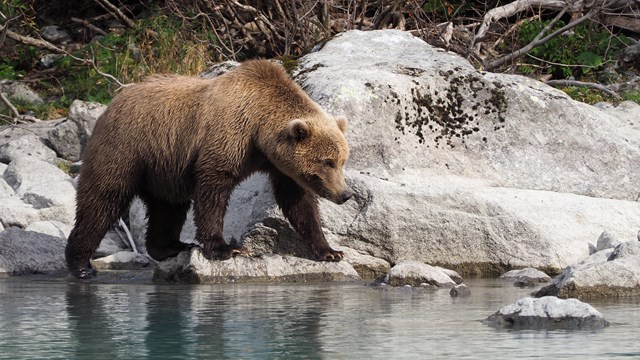
In the heart of the Chigmit Mountains, Crescent Lake offers fishing and bear viewing opportunities for visitors utilizing float planes.

A trip to Silver Salmon Creek offers both bear viewing and sport fishing opportunities along the coast and a tidally influenced river.
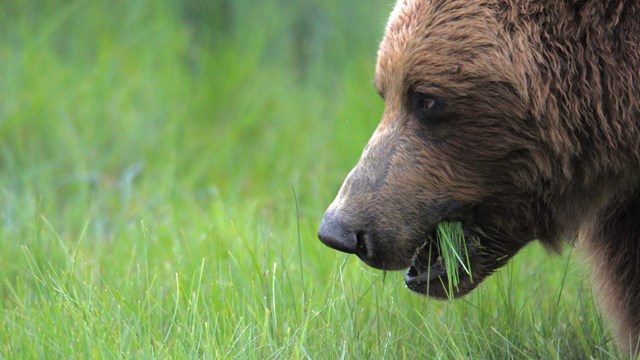
A trip to Chinitna Bay on Lake Clark's Cook Inlet coast offers a unique experience in the heart of coastal brown bear country.
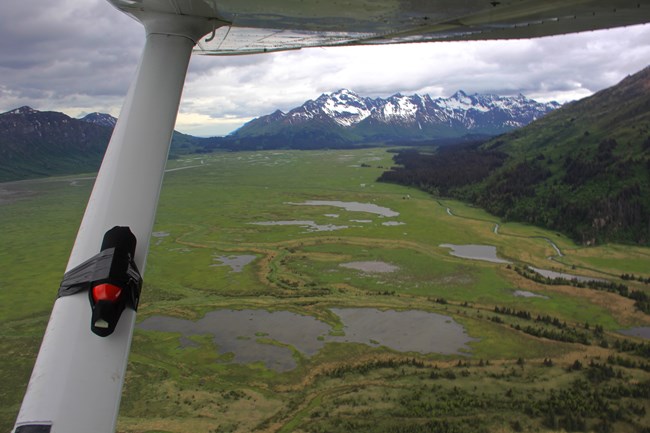
NPS/K. Ilgunas
Directions
Like many areas in Alaska, Lake Clark is not on the road system and travel takes place primarily by small plane. Fixed-wing aircraft are allowed to land on all suitable lakes, rivers, beaches, gravel bars, and open ground in both the park and preserve unless the area is closed or otherwise restricted.The type of plane used will depend on what you want to do and where you want to go. The first step is usually deciding where you want to go within the park and preserve and then finding a plane or air taxi that has the appropriate equipment to take you there. Please see each location's main page (linked to above) to find out landing gear appropriate for that location.
For summer travel, choosing an itinerary that utilizes either a plane with wheels or a plane with floats for water landings is important. Plan a trip that is conducive to one or the other as switching between the two types of landing gear can be time intensive and expensive. For instance, it would be unrealistic to go to both Crescent Lake and Silver Salmon in the same trip, even though on the map they look in close proximity. At Silver Salmon you must land on a beach and at Crescent you would need floats. There is no place to switch planes or landing gear in between these two locations.
For more information about directions to the park and air taxi services, please visit Lake Clark's Directions page.
Flying Safely
Lake Clark is rugged and remote. Planning ahead for flexibility and inclement weather is vital to a sucessful trip. Give yourself a few extra days on each side of your travel in the likely event of weather delays. In Alaska, we talk about the "circle of safety" where the passenger is a partner in ensuring a safe flight. Passengers should take an active role to ensure everyone's safety by getting familiar with the details of their trip. As a passenger, you should be willing to ask questions in a polite way if you feel uncomfortable about something or have additional questions.
Planes and Tides
Please do not circle the meadows while flying at low altitudes. Planes flying at low altitudes may frighten bears causing them to run towards groups of people, disrupt bear foraging activity, or cause bears to seek the safety of shelter and diminish bear viewing opportunities for others. Bears expect planes landing and taking off on the beach.
The tide measurement is Seldovia plus 30 minutes for both Chinitna Bay and Silver Salmon Creek. Both locations can have extreme tidal fluctuations.
- It is important to park your aircraft high on the beach and note that at high tide it is more difficult or impossible to land or take off.
- There are two sections of Silver Salmon Creek that are commonly crossed by foot (with waders) at low tide. They are not crossable within a few hours before/after the high tide, depending on the period of the tide cycle. The salt marsh too, gets wet as the tide comes in.
- Come prepared with rubber boots for everyone and hip or chest waders if you plan on crossing the river at low tide.
It takes everyone
Alaska Aviation Safety
Staying Safe in Bear Country
Bears and humans often frequent the same areas. In a coastal park like Lake Clark, both tend to spend time on the beaches and narrow bands of land found between the sea, or lakes, and the brush, forest, and steep cliffs nearby. It is likely that bears and people will encounter one another, but by remaining calm and following the basic advice of experienced bear behaviorists, you increase the odds of a positive outcome for both you and the bear.If you would like more information about this topic, see the park's main page about Staying Safe in Bear Country, watch the video below for recommendations for Silver Salmon Creek and Chinitna Bay, or watch A Trip To Crescent Lake.
- Duration:
- 11 minutes, 46 seconds
Thinking about visiting the park's Cook Inlet coastline? This short film offers a spectacular introduction to what your day may include and how to stay safe and protect the park's bear populations.
🐻🐻🐻🐻🐻🐻🐻🐻
Bear Viewing Best Practices
Interactions between bears and people are different in a high density area like those along the park's Cook Inlet coast where people come with the intent to observe the bears than it is in the remainder of the park. Learn how to stay safe in this environment by becoming familiar with the bear viewing best practices prior to your trip.Best Practices for Viewing Bears on the West Side of Cook Inlet and the Katmai Coast (see below) is a set of guidelines collaboratively developed between commercial operators, the National Park Service, and Alaska Department of Fish and Game. Operators are asked to follow these guidelines in the field and teach them to their clients. Chinitna Bay has designated viewing areas and the salt marsh is closed. Please check the current CUA stipulations and the Superintendent’s Compendium for a map of viewing areas and more information.
Silver Salmon Creek has no designated viewing areas and is open to the public. Please coordinate with other commercial operators to ensure visitor and wildlife safety. The NPS requests that guides group together at Silver Salmon Creek.
If people travel to the same places in the same way day after day, year after year, our behavior becomes predictable to bears, and they are more likely to view us as an unobtrusive part of their environment. If trails exists to designated viewing sites, such as those at Chinitna Bay, please use them.
When accessing viewing sites, people should strive to minimize disturbance to bears, bear habitat, and other people. When going to a viewing area on foot, it is usually best to be visible while approaching rather than sneaking into the area and possibly surprising bears. Bears don't like to be surprised, and can be dangerous if they are.
Each encounter is a learning experience for both bears and people. Appropriate and consistent human responses to bears minimize the chances of dangerous surprise encounters and can provide safer and better bear viewing experiences.
In most cases it is best to stay in the open where bears can see people and avoid them if they wish. Hiding from bears increases the likelihood that people will have a surprise encounter that could result in a dangerous situation for the bear and/or the person. Minimizing noise and movement while viewing bears will help limit disturbance to bears using the area.
Should I Camp Along the Coast?
The nutrient-rich vegetation, salmon-packed streams, and clamming potential of the park's Cook Inlet coast make it prime habitat for a dense concentration of brown bears. The high bear population is what attracts many visitors to places like Silver Salmon Creek and Chinitna Bay. If you plan to camp along these sedge meadows or beaches, come prepared for likely up-close bear encounters. Campers should be extra vigilant with food storage and plan for safe camping in bear country. Bear resistent food storage and electric fences are required in many areas. If you're considering camping during your bear viewing experience, please see the park's Camping Along the Cook Inlet Coast web page for requirements, closures, and other considerations.
Although brown bears are inherently solitary animals, they have developed distinct social cues and practices that allow them to live and eat near other bears. This is especially true around seasonally abundant food sources such as sedge meadows and salmon spawning streams.
If people learn to adhere to the rules bears observe for themselves, bears will more likely accept our presence as an unobtrusive part of their environment, and will continue to feed and carry on their natural behavior while being watched. Understanding bear behavior also reduces dangerous encounters and benefits both bears and people.
- If a bear that has been feeding calmly moves away at your approach, you have probably come too close. Do not pursue the bear at this point.
- Bears standing on their hind legs are trying to gain a better vantage to see or smell something in the distance.
- Boars walking in a bow legged, "cowboy" stance are expressing dominance. You will see this during the mating season in June as they try win dominance over other boars and thus the right to mate. It is also used to move others out of prime feeding or resting spots.
- A bear may open its jaws wide in close proximity to another bear's face that it is trying to impress. This often leads to play.
- Yawning can indicate that a bear is mildly irritated. Out of respect, avoid crowding a bear expressing this behavior.
- Huffing, sometimes accompanied by deeper throaty sounds indicates that a bear is nervous. If the bear is directing the huffing at you, it is time to give the bear more space.
- Jaw popping/ teeth clacking is a sign that a bear is very agitated and perhaps a little afraid. If you are close enough to hear it, you are too close.
- A bear that is very agitated may have its ears flattened against its head.
- A bear that lunges towards you or slaps the ground or surrounding vegetation is feeling threatened and telling you to "move away." Take this message very seriously.
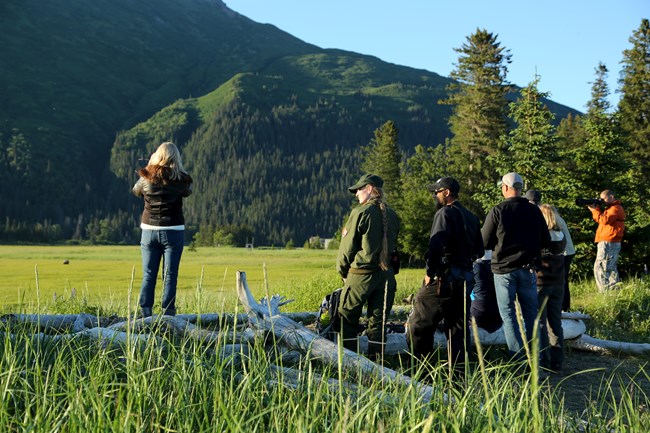
NPS/J. Pfeiffenberger
Park Rangers
Park Rangers are stationed at Chinitna Bay and Silver Salmon Creek throughout the summer. They travel by foot, bicycle or ATV and may approach your group to say hello, offer park brochure maps, Jr Ranger booklets or park passport stamps. They also check airplane tail numbers and CUA permits. They are knowledgeable about bear and salt marsh ecology and are happy to share their knowledge with you or your visitors or give site orientations.
Common Traffic Advisory Frequency (CTAF):122.9 and Marine Band 72 are monitored by rangers in both locations. For information or visitor questions, contact the ranger. At Silver Salmon Creek, local lodges also use Marine Band 72 and request that day guides bring marine radios to be able to communicate between each other in the field, coordinate viewing opportunities, and share information about bears.
If you cannot reach them via radio, they may be on a day off or inside the ranger station where it can sometimes be difficult to get reception. Guides and visitors are welcome to stop by the Ranger Stations.
- Silver Salmon Creek Ranger Station is located at: 59° 58.810’ N 152° 39.910 W. On the beach south of Silver Salmon Creek there’s a sandy trail from the beach through a patch of woods near the creek.
- Chinitna Bay Ranger Station is located at: 59° 52.240’ N 153° 05.430’ W. One mile east of the easternmost viewing area. There’s a sign on the beach with a trail to the cabin.
Key Park Regulations
- Human Waste: There is an outhouse on the trail to the eastern most viewing area at Chinitna Bay. Please remember that the rock outcropping at Chinitna Bay is private property and the property owners request that you do not take your visitors there to relieve themselves.
- Artifacts: There are important cultural sites throughout Lake Clark National Park. Removal of artifacts from federal land is prohibited by law. If you find something interesting please take a photo and report it to the National Park through the commercial services coordinator.
- At Chinitna Bay, the salt marsh is a critical habitat area for bears. It is closed to the public. Travel between viewing areas must be via trail and beach not directly between viewing areas.
- At Chinitna Bay, eating food is prohibited above the beach from Glacier Spit to the NPS Ranger Station (2 miles east). This restriction is intended to minimize the risk of negative human/bear interactions and prevent bears from associating food with the bear viewing area.
- At both Silver Salmon and Chinitna Bay, and within ½ mile of the Cook Inlet coast, food storage is required.
